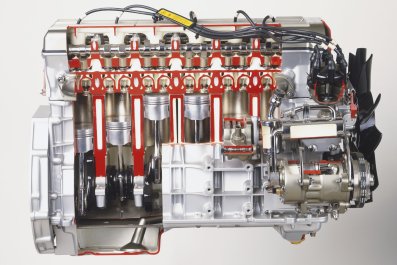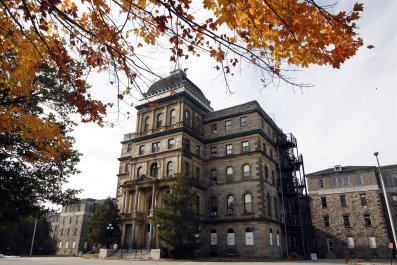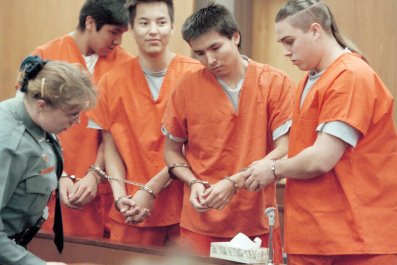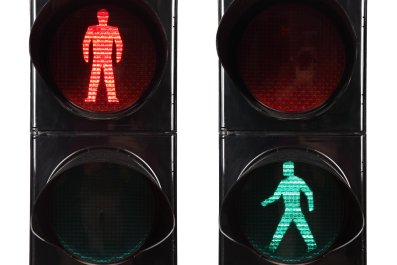For the past century, the greatest ticket to freedom for every teenager in the suburbs was a driver's license. After a lifetime of being chained to your parents—chauffeured around from school to practice to the homes of friends—there is no feeling more adult than the first time you take a car out alone. The next stage of your life has finally arrived, and you are barreling through it at 75 miles per hour.
Car culture was pervasive in the United States for years: The annual number of miles traveled by auto rose decade after decade. Until 2004, that is, when it stopped short. And today, younger Americans are changing their minds about the car. The number of high school seniors with driver's licenses dropped from 85 percent in 1996 to 73 percent in 2010. "Young Americans drive less than older Americans and use public transportation more, and often use multiple modes of travel during a typical day or week," concludes a 2014 U.S. Public Research Interest Group study.
The trend isn't easy to explain. Some have attributed it to the recession following the financial crisis of 2008, but interest in cars continues to wane as the economy rebounds. The study suggests a number of explanations: Millennials have no memory of consistently low gas prices; they are eager to latch on to technologically enhanced transportation services like Uber; universities have taken steps to significantly reduce the number of cars on campuses; and millennials have a stronger affection for more walkable communities and transportation alternatives than older Americans.
On the horizon, though, is a technological innovation that could reinvent car culture, return people to the road in droves and appeal to the environmentally conscious, tech-loving driver of the future. Except they won't be drivers in the traditional sense: Transportation experts agree that within the next 25 years Americans will start giving up their cars for vehicles that drive themselves.
Killing the Soccer Mom
Driverless cars are already finding their way into the mainstream. In 2012, Google started testing its cars on the roads of Silicon Valley and San Francisco. In October 2015, Tesla introduced a software update that allows its Model S to steer, change lanes and park without driver intervention. Google has suggested that its vehicles will become available to the public by 2017, and at the Consumer Electronics Show this year an entire section of the floor is dedicated to "Vehicle Intelligence," featuring technology from companies "that support the future of autonomous/automated driving, including parking assist, collision avoidance, emergency braking and much more." In other words, it's only a matter of time before humans let go of the wheel altogether. Within 100 years, young people won't even remember a world in which a human drove.

When they do finally arrive en masse, self-driving cars will unleash a wave of changes—especially in the United States, where the largest cities were built (or rebuilt) in the golden era of the automobile and lives are built around driving. According to the Texas Transportation Institute, American commuters spent almost 7 billion hours inching their way toward work or home in 2014—and paying for it in more than just lost time and money. Studies have found that people with commutes longer than 40 minutes are unhappier, more stressed and generally experience more worry than those who only have a 10-minute commute. A study in Sweden that tracked more than 2 million married Swedes found that people whose commutes are 45 minutes or longer are 40 percent more likely to get a divorce than those with shorter commutes. A study out of New York University looking at 21,000 U.S. commuters found that there was a strong correlation between length of commute and hypertension. Another study out of Texas that looked at 4,297 adults found that commuting distance was associated with larger waist circumference and higher blood pressure. And finally, another study out of Sweden that looked at 21,088 Swedes confirmed previous research that commuting contributed to poor sleep quality and everyday stress.
For commuters, driverless cars bring good news: "The driverless car will smooth the traffic flow," says Egil Juliussen, director of research and principal analyst of automotive technology at IHS, an analytics firm. "The lights will be coordinating [with the cars], so you don't have all that stop and go." The amount of time people spend in traffic jams will decrease significantly, and that could reduce the amount of pent-up stress and anger many commuters feel, says Jay Lebow, a psychology professor at Northwestern University's Family Institute. Additionally, "you can use the time better," he says. "There is a helpful effect. It might promote more leisure time."
Of course, not everyone takes their car into work, but when driverless cars start arriving in fleets, subways, light rail and bus lines could end up being replaced (or at least greatly supplemented) by a new mobility industry. It'll be like Uber, Lyft and the dozens of other on-demand car services that have popped up in the last six years—on steroids. And without drivers.
[Related: Faraday Future Reveals Its Wild New Concept Car]
In places like New York City, where public transportation is completely entrenched, things might not change all that much. But in Los Angeles, where the words subway or bus are often met with laughter, public transportation could become extinct. Instead, cities like L.A. may start running fleets of driverless public transportation cars and vans. It'll improve the transportation network, and cities will save money by making the switch, says Juliussen, because there won't be any more need for fixed stations to support light rail or bus routes—just call a driverless vehicle from wherever you are.
Shared self-driving cars will also gradually replace the personal vehicle. "Cars are idle 95 percent of the time, so they are an ideal candidate for the sharing economy," says Carlo Ratti, director of MIT's Senseable City Lab. "It has been estimated that every shared car can remove about 10 to 30 privately owned cars from the street." In the future, people—and families—may stop owning cars. Instead, they'll be licensors, owning the right to use a car (or sit in car) for a period of time, shared with others. Even car manufacturers themselves are betting on this future: Lyft announced in early January that General Motors had invested $500 million in the ride-sharing service company. "We think there's going to be more change in the world of mobility in the next five years than there has been in the last 50," said GM President Daniel Ammann.
That means we can probably say goodbye to the "soccer mom." There will no longer be a need for a member of the family to dedicate days to chauffeuring kids to school, ballet class and soccer practice. A family will be able to give up their now-average 2.5 cars and opt for a share in one driverless car that will take the kids to school in the morning, then swing back around to bring Mom and Dad to work. Families will also have increased mobility, since no one will need a driver's license (or even the ability to see) to get around. It will be a boon to the elderly and anyone who otherwise wouldn't be able to drive. And Mom and Dad won't have to leave the office early to make sure their kids are at hockey practice or guitar lessons.
There will still be people who want to drive, but the driveway tinkerer—who works on rebuilding classic cars and drives them around the neighborhood with the top down—will no longer exist. We might not even have garages or driveways. And some experts expect that human-driven cars might even be banned in some, or all, places. The car enthusiast will have to hitch his Mustang up to a driverless car and take it to a different kind of driving range—where he can tool around on a closed course.
Meanwhile, says Chandra Bhat, director of the Center for Transportation Research at the University of Texas, public transportation will become much more efficient by cutting out low-volume routes. People who live in areas that aren't as highly populated will rely solely on car services (or their share in a driverless car).
Bhat says that states considering big high-speed rail projects—like California—may rethink their plans. "What does high-speed rail achieve? It allows us to travel without having to drive. But with driverless cars, you're not driving," he says. That means you can be completely flexible about when you travel and what you do while on the road. Maybe you drive overnight and sleep the whole way. Or maybe you spend the whole trip working. After all, when your attention no longer needs to be on the road, you can do almost anything inside your car. The automobile of the future might not even have traditional car seats—instead, it might have couches or beds. Perhaps it will even have small kitchens or entertainment centers; cars could easily become mobile living rooms with all of the amenities.
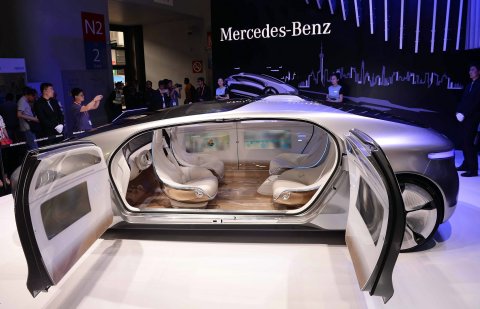
The highways of the future will be filled to the brim with cars traveling 3 to 4 feet apart from one another while going 60 to 70 mph, passengers kicking back and doing whatever it is they want to do. This will significantly increase the capacity of roads, and the number of cars that travel on them will skyrocket. Massive intercar communications networks will help them all run efficiently and safely. And that means a huge burden on the world's global positioning system networks—better known as GPS. The U.S. has 24 satellites in the sky that run its GPS systems, which many software manufactures use in tandem with 24 of Russia's positioning system satellites, called GLONASS. That's fine for now, but in order to manage worldwide fleets of cars that rely on digital maps to find their way around, someone—countries (Europe, China and maybe India) or car manufacturers or fleet owners—will have to launch new satellites. According to Juliussen, the number of satellites in low-Earth orbit "goes to 120 by the early- to mid-2020s or so."
What that means is we won't just have an electrical grid anymore. We'll have a new type of closed system—a car grid—that features a worldwide network of moving parts controlling all of the Earth's cars. Our cars will all talk to the grid, and through the grid, they will also talk to one another.
Like Preschool Parking Lots
Humans are flocking to cities now more than ever. According to the World Health Organization, urban population worldwide was 54 percent of the human race in 2014, up from 34 percent in 1960. But will everyone want to live in the city when their commute becomes so much easier? There's a chance the driverless car revolution will propel a suburban exodus bigger than was seen post–World War II.
On the other hand, with a massive fleet of on-demand, self-driving cars, there will be no more worry about the downtown traffic on Friday nights, where to park when you arrive, surge pricing when all the Uber drivers are busy or squeezing into overcrowded subway cars at peak hours. Still, it's possible that "location, location, location" won't be able to sell cramped condos anymore.
People could instead just live any old place. And when it no longer matters where people live, it also won't really matter where they work. Maybe everybody will still go to work downtown, and the street in front of office buildings will look like preschool parking lots at the end of the day with driverless cars lined up waiting to take workers home. But that seems unlikely, given that the idea of the office has been changing. We're already trending toward a world of telecommuters, and the number of freelancers is on the rise. According to a recent Gallup poll, 37 percent of the U.S. workforce telecommuted in 2015, up from just 9 percent in 1995. If contract workers are the new normal, and the location of the office no longer matters, then the office itself might disappear completely. "Will we even have designated workplaces?" Bhat asks. "The technology is so ubiquitous for communication the whole concept of the home and workplace could vanish."
If more people move away from the cities and suburban sprawl increases, the environment will take a hit (see: L.A.). But if people use significantly fewer cars and all those cars are electric, which seems likely (industry leaders Google and Tesla build only electric cars), then it won't.

On the other hand, getting human hands off the steering wheel might make cities much more green, and livable. For example, all the space currently taken up by parking is going to be put to a more environmentally friendly new use. "I think we can just let our creativity run wild," says Ratti, who imagines there will be many more green spaces in cities. Transforming parking garages will be more difficult, Ratti says, because their floors are angled—not really ideal for most of the things humans like to do in open spaces, like play soccer or host flea markets. However, that might change as well: "In a current design project in Singapore, we are already designing a very large parking structure by thinking about how it could be converted," he says. "You want to have horizontal floors instead of sloping ones and a slightly higher than normal floor-to-floor height to allow for other uses."
According to Erick Guerra, a city planner at the University of Pennsylvania School of Design, over the next few decades, the smarter urban planners and civil engineers—the ones who anticipate the arrival of the self-driving car—will start to put streets on "road diets." In the suburbs, that means highways won't be widened and fewer new ones will be built. In the cities, some lanes will be repurposed for biking, and roads will get more pedestrian-friendly features like wider sidewalks and easier crossings.
An invisible but potentially huge change, Ratti says, is the convergence of cities with the digital world. Our cars and our cities will talk to each other, share information and track data. It's already beginning to happen: The Center for Urban Science and Progress at New York University is working with New York City to harness the massive amounts of data generated there on a daily basis from things like Metrocard swipes, closed-circuit camera footage, tweets about traffic and smart energy meters. This information is already making cities more efficient. For example, CUSP is helping the city analyze overcrowding in subways, as a result it has begun to increase service on at least one line and unveiled new digital apps to help commuters manage the system.

Once cars on the streets are linked into a single citywide network that shares all data, those efficiencies will be able to happen on the fly, making them even more powerful. Cars will be able to identify problem intersections that cause congestion and avoid them or even spot and report small crimes happening on the street. Reporting everything that happens around every car in a city will make big data and its benefits even bigger. It'll save time, money and lives.
Nothing to Get MADD About
It's a moment we all know too well. Traffic slows and you inch your way along the highway wondering why, out of nowhere, you've lost all forward momentum. And then you see it, up ahead, flashing lights. A drunk driver has wrapped his car around a tree, a line of tailgaters has caused a pileup, or someone has fallen asleep behind the wheel and drifted into oncoming traffic. Every year in the U.S., more than 35,000 people die in car accidents. It's a reality that we all accept every time we climb behind the wheel: Driving is dangerous.
But once humans aren't allowed behind the wheel, they'll lose the power to cause accidents. Human error is the main reason for most car crashes. In July 2008, the U.S. Department of Transportation released a report to Congress called the National Motor Vehicle Crash Causation Survey. After studying 6,950 crashes over a period of three years they determined that 93 percent of all the accidents were caused by human error: Among other things, people were distracted, they were traveling too fast, they misjudged the other driver or their own abilities, they overcompensated after an error, they panicked or, in 3 percent of cases, they were asleep. Removing humans from the equation will eliminate every one of those problems. According to a 2015 study by McKinsey & Company, fatalities from car accidents could fall by as much as 90 percent, saving $190 billion, when driverless cars take over.
It's a huge public health benefit that will ripple through the health care, law enforcement and insurance sectors. A recent study by the insurance, tax and auditing firm KPMG found that if accidents drop by 80 to 90 percent, the personal auto insurance sector could also fall by as much as 60 percent due to lost premiums. Some of that could be made up by insuring manufacturers, who will likely take on the burden of responsibility for car-related accidents. After all, it's their software that will control how cars drive, so it will be on them to prevent fender benders.

The elimination of impaired drivers means there will also be less need for highway patrol—after all, driverless cars don't speed, have heart attacks behind the wheel or drive drunk. In fact, the demographic of the highway will change. The long-haul truck driver, for example, whose living is made traveling back and forth across the country will no longer be needed. Delivery services like FedEx or UPS won't need to employ nearly as many people. Trucks can easily be loaded by machines, then transported without a driver to a central location. Once your package arrives at a local warehouse you can send your car to pick it up. There's little to no human intervention needed. That means a loss of jobs for the nearly 3.5 million professional truck drivers around the country.
It's unclear how the self-driving car revolution will impact the job market overall. On the one hand, it seems like there will be huge cuts to both the public and private transport sectors. New York City's Metropolitan Transit Authority employs more than 65,000 people, and according to the U.S. Bureau of Labor Statistics there were about 665,000 jobs for bus drivers in the U.S. in 2014. In the future, whether public transportation sees increased or decreased use, it will certainly become driverless. And according to the U.S. Bureau of Labor Statistics, there were more than 230,000 taxi and chauffeur jobs in the U.S. in 2014—all of which stand little chance of making it through the self-driving car revolution. Other sectors will grow: Juliussen says driverless cars will need to be replaced every three years due to their increased use, so manufacturers may stand to benefit from an increase in sales.
California Scheming
None of this is really all that new. In 1918, just a few years after the automobile began mass manufacturing in the U.S., Scientific American wrote: " The car of the future will have no such thing as a 'driver's seat.'... Driving will be done from a small control board, which can be held in the lap... A small finger lever, not a wheel, will guide the car." It sounds almost like they are describing the driverless car coming our way soon.
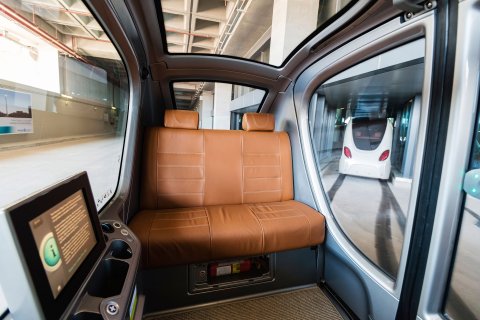
And, like today, people back then thought the car of the future would be the world's savior. "City planners looked at the car as the solver of urban planning problems—most of which were related to density," says Guerra. In some ways, those predictions were accurate: Cities today have higher populations, but inside them people aren't packed so tightly. And we certainly don't live with the health risks posed by the mess that horse-based transportation leaves behind.
But the car wasn't the answer to all of humanity's problems. We replaced human congestion with traffic jams, air pollution and acid rain. We fight over drilling rights, and the economies of entire nations hang on the price of a barrel of oil. The driverless car will bring with it a slew of benefits and drawbacks that we can do our best to predict—but there's no way we can dream up everything that's to come. There are two things, though, that we can say with confidence: Driverless cars will radically change the way we live, and 100 years from now no one will hear the words Los Angeles and automatically think "carmageddon."









